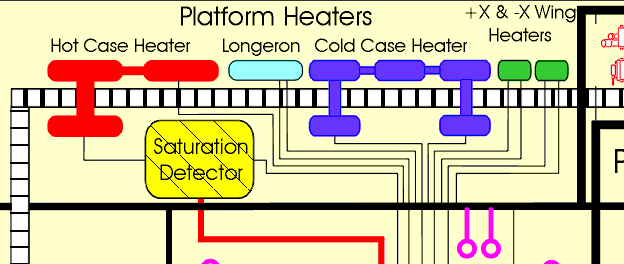Platform Heaters - Ulysses
Power & Thermal Subsystem

Platform Heaters
The spacecraft heaters provide local heating to units that are exposed to low temperatures during phases of the mission when the spacecraft is a long way from the Sun. Of particular concern are any fuel-bearing components, as hydrazine freezes at approximately 2 °C and can become unstable when thawed. Units outside the spacecraft thermal enclosure, such as the Sun Sensors, are also of concern.
The Hot Case Heater
The Hot Case Heater heats the coldest sections of the Reaction Control Subsystem (RCS), those sections most exposed for the longest periods of the mission. This heater was switched on after Ulysses deployment from the Shuttle, after launch, and has only been switched off for a brief period during the early mission since then. The Hot Case Heater dissipates 8.9W to the fuel tank, hydrazine fill and vent valve, the X wing pipelines, and the two thruster blocks. Its called the 'Hot Case' heater because it was designed for use during the mission's hottest thermal case, i.e. when Ulysses had just been deployed from the Shuttle when solar heating on the spacecraft was most intense.
The Hot Case Heater current is monitored by a Saturation Detector. If this curcuit drops below rated power for more than 24 seconds, the Saturation Detector disconnects the payload from the Main Bus by opening the Main Switch. Since the payload science instruments consume about 55W, this action, termed a "Disconnect Non-Essential Loads" (DNEL), should restore sufficient power to ensure heater saturation.
The Cold Case Heater
The Cold Case Heater heats the sections of the RCS and spacecraft exposed to low temperatures when the spacecraft is not sufficiently close to the Sun to keep the components warm by solar heating. This heater is generally switched on when the spacecraft is beyond 2AU (about 185 million miles) from the Sun - however the decision is made based on component temperatures on the spacecraft, not on distance. The Cold Case Heater dissipates 24.9W to the central pipelines inside the spacecraft thermal enclosure, the latching valves, pressure transducers, and filters, the -X wing pipelines, and the two thruster blocks. Its called the 'Cold Case' heater because it was designed for use during the mission's coldest thermal case, i.e. when Ulysses has passed that point in its trajectory when it was furthest from the Sun, but the decreasing solar range had not yet compensated for thermal effects of decreasing RTG power.
The X Wing Heaters
The Wing Heaters are located on the thruster blocks, and are solely for heating that local area. The +X and -X Wing heaters dissipate 1.4W and 1.8W respectively, and are each capable of raising the thruster block temperatures by about 10 °C. These heaters can be switched independently, as for scientific reasons it is important to keep the wing temperatures within 10 °C of each other, however in practice it is found that the thruster block temperatures usually match to within 2 °C and the heaters can be switched together when it is necessary to warm or cool the blocks.
Longeron Heater
The Longeron Heater is installed on the -X/+Y longeron, near the hydrazine fill & vent valve bracket. This heater compensated for heat loss to the Shuttle Payload Adapter during the launch phase, which could have caused freezing of the valve. The Longeron Heater was specifically for the launch phase, and is now no longer used.








































 Sign in
Sign in
 Science & Technology
Science & Technology